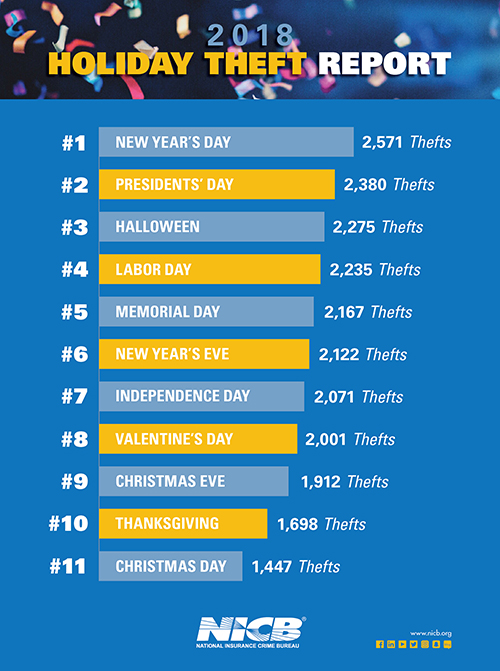NICB Releases Annual Holiday Theft Report
22,879 vehicles stolen on 11 holidays
DES PLAINES, Ill., Oct. 23, 2019 — New data released today by the National Insurance Crime Bureau (NICB) shows a total of 22,879 vehicles were reported stolen on the 11 holidays in 2018 covered in this report. NICB theft data is pulled from the National Crime Information Center’s (NCIC) stolen vehicle file.
Release Resources: Report | Infographic
New Year’s Day tallied the most holiday thefts with 2,571. It was followed, in descending order, by Presidents’ Day (2,380), Halloween (2,275), Labor Day (2,235) and Memorial Day (2,167).
Here are the 2018 holidays in ranking order:
- New Year’s Day (2,571)
- Presidents’ Day (2,380)
- Halloween (2,275)
- Labor Day (2,235)
- Memorial Day (2,167)
- New Year’s Eve (2,122)
- Independence Day (2,071)
- Valentine’s Day (2,001)
- Christmas Eve (1,912)
- Thanksgiving (1,698)
- Christmas Day (1,447)
California was the number one state with the most holiday vehicle thefts in 2018 with 4,797. It was followed by, in descending order, Texas (2,144), Florida (1,322), Washington (819) and Georgia (778).
In 2018, there was an average of 2,199 vehicle thefts each day. While this report just looks at the 11 holidays, every day vehicle theft is a problem across the nation. NICB recommends that drivers follow our four “layers of protection” to guard against vehicle theft:
Common Sense — the common sense approach to protection is the easiest and most cost-effective way to thwart would-be thieves. You should always:
- Remove your keys from the ignition
- Lock your doors /close your windows
- Park in a well-lit area
Warning Device — the second layer of protection is a visible or audible device which alerts thieves that your vehicle is protected. Popular devices include:
- Audible alarms
- Steering column collars
- Steering wheel/brake pedal lock
- Brake locks
- Wheel locks
- Theft deterrent decals
- Identification markers in or on vehicle
- VIN etching
- Micro dot marking
Immobilizing Device — the third layer of protection is a device which prevents thieves from bypassing your ignition and hot-wiring the vehicle. Some electronic devices have computer chips in ignition keys. Other devices inhibit the flow of electricity or fuel to the engine until a hidden switch or button is activated. Some examples are:
- Smart keys
- Fuse cut-offs
- Kill switches
- Starter, ignition, and fuel pump disablers
- Wireless ignition authentication
Tracking Device — the final layer of protection is a tracking device which emits a signal to police or a monitoring station when the vehicle is stolen. Tracking devices are very effective in helping authorities recover stolen vehicles. Some systems employ “telematics” which combine GPS and wireless technologies to allow remote monitoring of a vehicle. If the vehicle is moved, the system will alert the owner and the vehicle can be tracked via computer.
